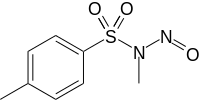Diazald
 | |
| Names | |
|---|---|
| IUPAC name
N-Methyl-N-nitroso-p-toluenesulfonamide | |
| Other names
Diazald, N-methyl-N-nitroso-4-methylbenzenesulphonamide | |
| Identifiers | |
| 80-11-5 | |
| 3D model (Jmol) | Interactive image |
| ChemSpider | 6376 |
| ECHA InfoCard | 100.001.139 |
| EC Number | 201-252-6 |
| MeSH | C418734 |
| PubChem | 6628 |
| |
| |
| Properties | |
| C8H10N2O3S | |
| Molar mass | 214.24 g mol−1 |
| Appearance | light yellow solid |
| Melting point | 61–62 °C (142–144 °F; 334–335 K) |
| Hazards | |
| Main hazards | skin sensitiser, irritant, explosive[1] |
| Safety data sheet | External MSDS |
| NFPA 704 | |
| Except where otherwise noted, data are given for materials in their standard state (at 25 °C [77 °F], 100 kPa). | |
| Infobox references | |
N-Methyl-N-nitroso-p-toluenesulfonamide, known commercially as Diazald, is used as a relatively safe and easily handled precursor to diazomethane, which is toxic and unstable.[2]
Upon the addition of a base such as sodium hydroxide or potassium hydroxide, an elimination reaction occurs to produce diazomethane as well as p-toluenesulfonic acid as a side product, according to the following mechanism:

References
- ↑ External MSDS, Sigma Aldrich
- ↑ Diazald in Chemical Synthesis, Sigma Aldrich
This article is issued from Wikipedia - version of the 10/9/2016. The text is available under the Creative Commons Attribution/Share Alike but additional terms may apply for the media files.
